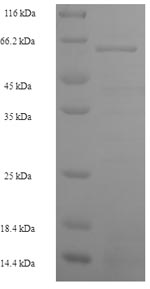The expression region of this recombinant Human SKP2 covers amino acids 1-424. The theoretical molecular weight of the SKP2 protein is 63.8 kDa. The SKP2 protein was expressed in e.coli. Fusion of the N-terminal 6xHis-SUMO tag into the SKP2 encoding gene fragment was conducted, allowing for easier detection and purification of the SKP2 protein in subsequent stages.
Human S-phase kinase-associated protein 2 (SKP2) is a key regulator of the cell cycle, specifically the G1 to S phase transition. SKP2 targets cell cycle inhibitors for ubiquitin-mediated degradation, promoting cell cycle progression. Studying SKP2 contributes to insights into cancer biology, cell cycle regulation, and potential therapeutic strategies targeting cell proliferation and differentiation. In cancer research, SKP2 is associated with tumor development and progression. In cell biology, it is crucial to understand cell cycle control. Additionally, SKP2 plays a role in stem cell maintenance.






